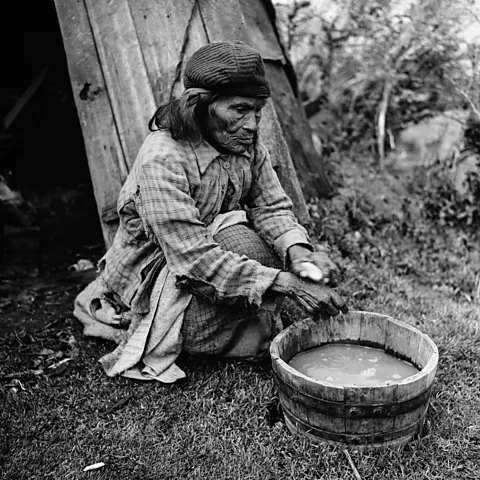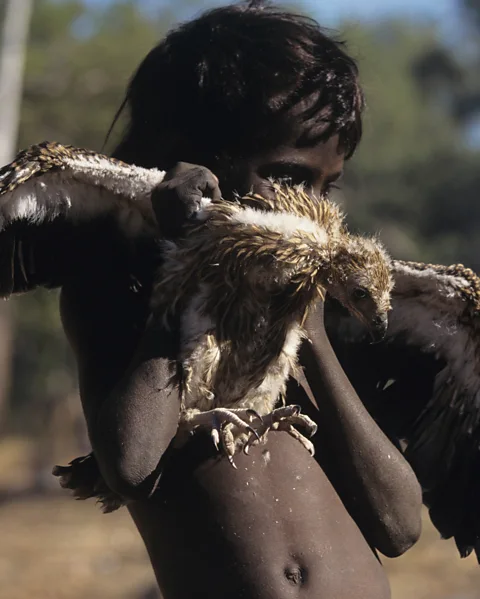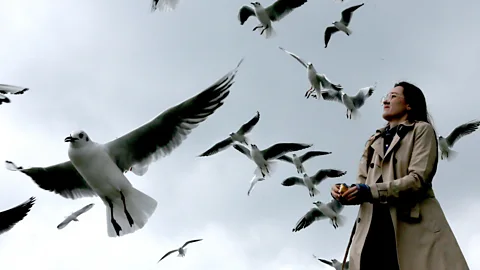Why local legends about birds matter
 Alamy
AlamyThe stories of enigmatic birds told in indigenous folklore aren't just fascinating tales, they may be a way to preserve languages and cultures at risk of extinction.
In the farthest reach of the southern cone of South America, along the wind-and-rain-whipped coast of Tierra Del Fuego, the Yaghan people have a story about the Magellanic woodpecker, a big showy bird they call lana.
A boy and his sister were picking red berries away from their village. Attracted to each other, they finally gave in to their desires.
The moment they did they were turned into a male and female woodpecker.
That story was told by Christina Calderon, a 94-year-old woman who is one of 1,600 Yaghan people, but is also the last person for whom Yaghan is their first language.
One effort to preserve her native tongue, and with it the Yaghan perspective on the natural world, is the curation of Calderon's traditional stories about birds, which offer a glimpse into a very different way of living. In this case it was lesson about a taboo, which could reduce genetic fitness.
"To the Yaghan the birds are companions and teachers," says Ricardo Rozzi, an ecologist at the University of North Texas and the author of A Multi Ethnic Bird of Sub Antarctic Forests of South America, a combination of scientific data alongside Yaghan bird names and stories. "When you see animals as fellow beings it changes the ethical relationship with the world."
 Getty Images
Getty ImagesGlobal biodiversity is in a free fall. A major UN report last year found that one in four species is imperiled. But the problem is not only an extinction of species – intimate knowledge of the world around us is also disappearing as people reduce their engagement with nature.
Ethno-ornithology, a tiny discipline, came about when ornithologists studying tribes realised that these cultures related to birds in vastly different ways than our own and in studying biology they were getting only a small, distorted picture of a rich, ancient and holistic relationship that had evolved over thousands of years.
Capitalising on the charisma of birds, their transcendental appeal and the pervasive role they play in thousands of cultures around the world, a small cadre of researchers is documenting not only bird stories but the perspectives they provide before they slip from memory. The preservation effort has received a high-tech boost from the recent launch of the Ethnoornithology World Atlas, an online repository that is a collaboration between BirdLife International and the University of Oxford that allows ornithologists, indigenous people, anthropologists, biologists and others who want to preserve indigenous knowledge, to upload video interviews, reports, photos and other material.
"Everything has been driving indigenous cultures toward a global culture which doesn't really value them," says Andrew Gosler, a professor of ornithology at the University of Oxford and the research director of EWA. "So, we hope to provide something that will help affirm the importance of local knowledge and local languages, and local customs and cultures which are connected with the local environment."
Now, because many of the dwindling languages and customs are held by a handful of ageing tribal members, Covid-19 is accelerating their disappearance. The virus is ravaging the nation of Brazil, for example, but the mortality rate is twice as high for indigenous people in the Amazon. The Munduruku people, according to the Guardian, have lost 10 "wise ones", described as living libraries by a tribal leader.
 Getty Images
Getty ImagesOne of the last four speakers of the Great Andamanese language, Sare, a woman named Licho, died last April of tuberculosis. The Sare language, was the focus for the Birds of the Great Andamanese by Anvita Abbi, an Indian anthropologist and ethnoornithologist who sought to preserve the language of the handful of people who live on islands off the coast of Thailand.
Many native languages have been greatly diminished, in large measure because they were suppressed by the Catholic Church, governments, and others in the last century as a way to force indigenous people to acculturate. Native Americans describe being beaten or having their mouths washed with soap for speaking their own language.
Of the 7,000 or so languages extant today, 40% may disappear in the coming decades, according to the Endangered Language Project.
As bird tales disappear it's not only the languages at risk but also the world views they express – tens of thousands of years of accumulated ecological, biological and cultural knowledge. "Every last word means another lost world," is how the Living Tongue Institute for Endangered Languages puts it.
A recent study found, for instance, that most of the indigenous knowledge about medicinal plants in North America, northwest Amazonia, and New Guinea are to be found in one language in each of the regions.
Another Ethics 101 tale for the Yaghan, for example, is a story of a heroic hummingbird – which they call omora, or "little spirit" – that battles a wily fox that has fenced off water during a drought. The bird kills the fox and allows the Yaghan to access the water. The lesson is "there is always a duty to share", says Rozzi. "Private property is called into question always."
 Alamy
AlamyBirds, central to so many different indigenous ways of life, portray the ways cultures inhabit and perceive the natural world, which bird stories tell us is almost unimaginably different to non-indigenous cultures. Many indigenous people have their own science.
The Bosavi people of Papua New Guinea, for example, create "song maps" – they sing complex and poignant story songs about recently departed relatives by describing the places they hunted and gardened, along with a particular quality of the light and the sound of water in those places – all somehow captured through the eyes of a bird imagined soaring over the landscape.
Researchers gathered the location of some 7,000 of these places. "When you put all of those points on a GPS, they don't overlap and it's a map, a poetic cartography of the forest," says Steven Feld, an anthropologist and senior scholar at Santa Fe's School for Advanced Research, who studied the Bosavi for more than 25 years. In a clash of old and new, Feld says this traditional map has been used to negotiate a right of way with Exxon for a natural gas pipeline.
And while we may enjoy the trill of bird song, the Bosavi hear in the songs of 125 species near their village, a richly detailed ecological portrait. "They instantly know the time of day, the season of the year, what layer of the forest canopy the bird is in, what fruits are in season, soil acidity changes, the knowledge of the migratory situation, who's nesting where.
"Listening becomes a science journal, a system for sensing on an everyday basis and putting into memory all of the diagnostics we would be writing down or using equipment to measure," says Feld. "It's a deep science."
Fathoming alternative ways of sensing the world can tell us much about the varieties of perception. Felice Wyndham, an ethnoornithologist and ethnobotanist who works on the EWA project, says peoples she has worked with have the ability to move their consciousness out of their body and intimately sense the world, which she called a "heightened form of mindfulness".
"It's quite common, you see it in most hunter-gatherer groups," she says. "If you are in a highly diverse and sensuous natural environment, you are also going to be doing that with all of the organisms, the plants, the water and the birds – especially the birds – because they fly and it gives you a completely different perspective."
There is also information for biologists in the world's traditional bird knowledge. In Australia researchers learned from aborigines that some birds the locals call "firehawks" – the common names are whistling kite, black kite and brown falcon – pick up flaming twigs from one fire to start another, to flush out prey. In collaboration with indigenous people they documented it and published a paper.
 Getty Images
Getty ImagesThe EWA is open to anyone who wants to peruse it, though uploading information requires an account. It also has restrictions: it allows people who tell these bird stories to decide how their information will be used – some held in a private area so only tribal members can view it.
"It provides communities control over what and how ecological knowledge is shared with the public, and fosters transparency between outsider researchers and communities working in partnership," says Wyndham. There have long been complaints that some researchers have appropriated local knowledge.
It also helps make the work more culturally accurate. "If I am working with Ayoreo communities of Paraguay on bird knowledge I can post all the names, interviews, pictures, as we collect them, and Ayoreo partners who have access to the internet can review, comment and edit as needed," Wyndham says. "This is a revolution in how this kind of research is usually done."
If young people of a culture are keenly interested again in the old stories, Wyndham says, they can turn to the EWA. The database is not just about preserving cultural knowledge of nature in far-flung corners though.
 Getty Images
Getty Images"Half of our first-year students in biology can't name five British birds and 20% can't name one," says Gosler. "That's a common story across the world."
Yet, he says, one 19th Century study shows that there are 78 passerine birds in England that once had 7,000 folk names. When those names vanished common local knowledge about their biology and behaviour went with them. (Read more about how knowledge of nature is lost between generations.)
One portal in the EWA contains the work of Michel Desfayes, a nonagenarian Swiss linguist and amateur naturalist who gathered more than 100,000 folk names for 600 species of birds throughout Europe, in many different languages. Every valley once had its own name for the same birds. "They say a huge amount about how people related to birds across Europe for thousands of years," says Gosler.
As natural experiences dwindle an emotional investment in protecting nature goes with it – that may be part of why birds are in steep decline.
"When you say to students 'Did you know that this species has declined 70% in the UK?' it means nothing to them," Gosler says. "They say 'Why should I care? I didn't know that bird existed until you told me.'"
But as they hear the bird folk knowledge of Britain or hold a bird with fluttering wings in their hand to band it, he says, "it is a life-changing experience for them. Then they care."
--
Jim Robbins is the author of The Wonder of Birds, What They tell us about Ourselves, the World and a Better Future, published by Spiegel & Grau in the US and Black Inc. Books in the UK/Commonwealth.
--
If you liked this story, sign up for the weekly bbc.com features newsletter, called "The Essential List". A handpicked selection of stories from BBC Future, Culture, Worklife, and Travel, delivered to your inbox every Friday.
